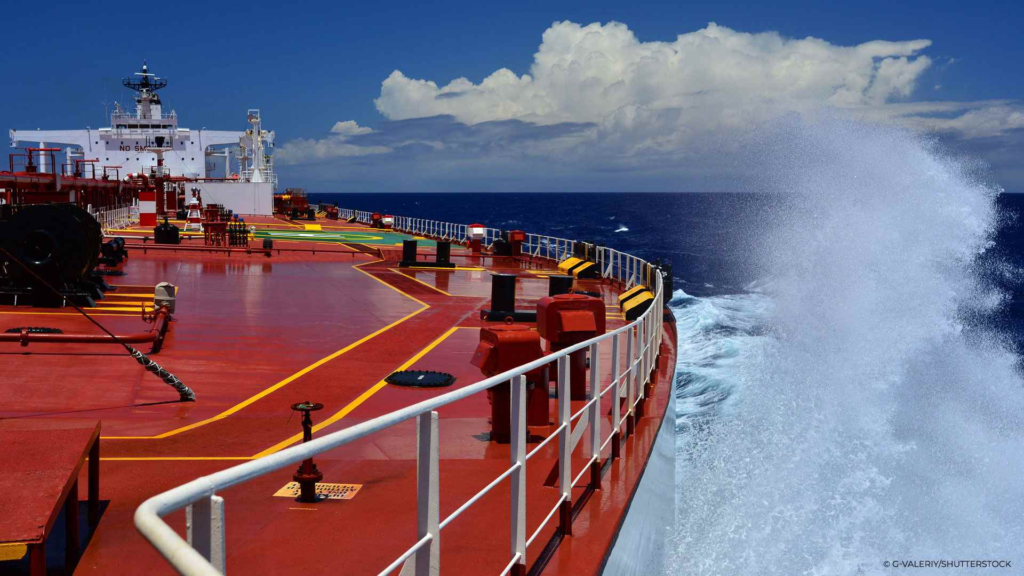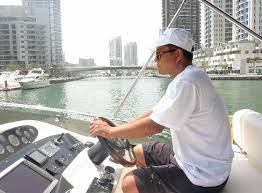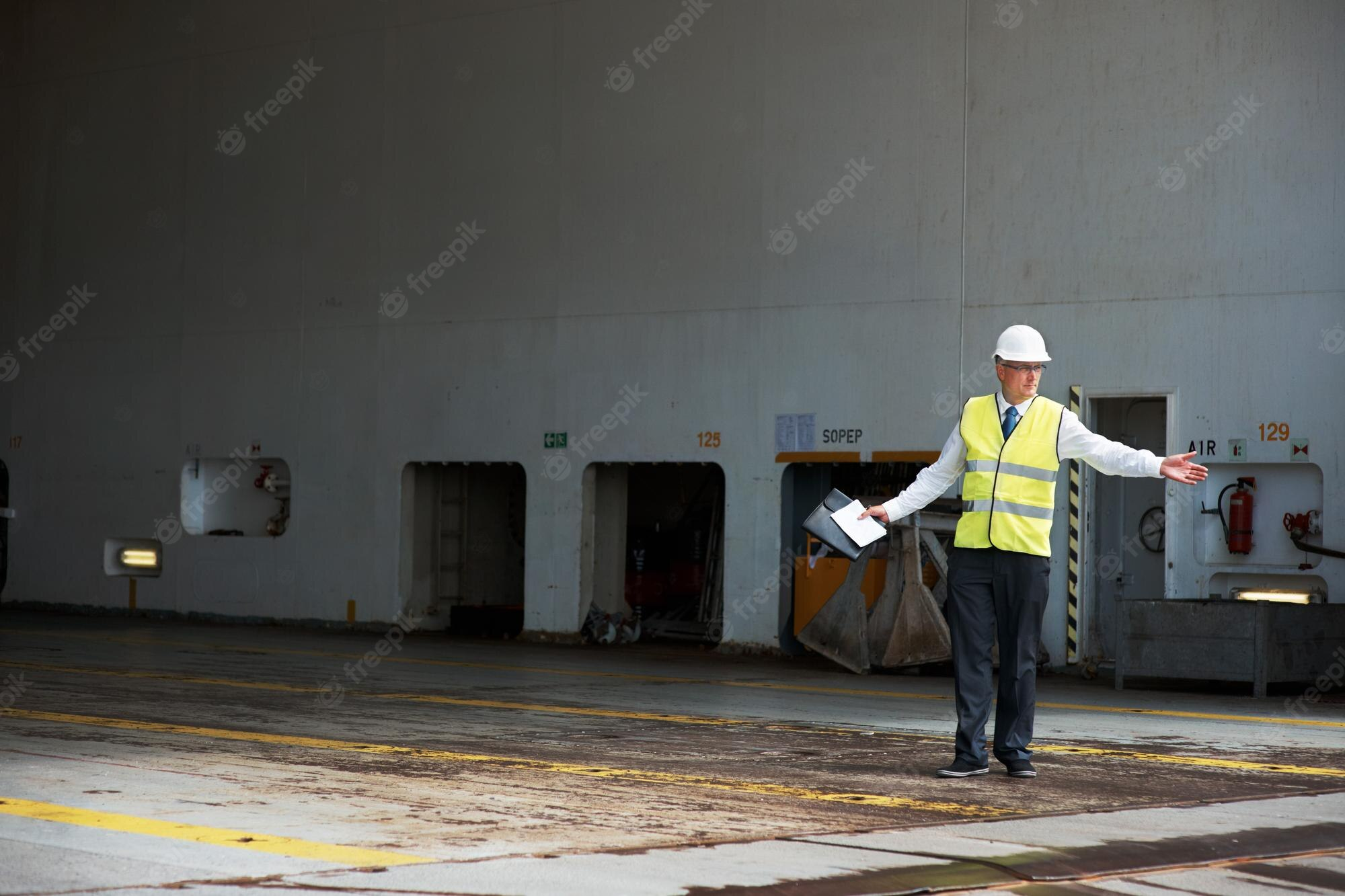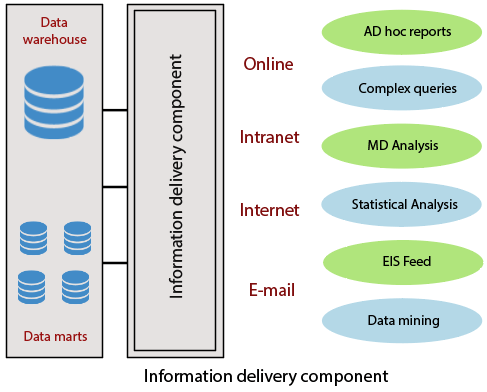Vessel Operator Grade 3
Vessel Operator Grade 3 click here
Brief Job Description: The individual is responsible for overall boat operations and
ensures safety, security and facilities on the vessel. S/He plans and leads the
specialised operations like passenger vessel, tug vessel and NCV operations.
Qualifications Pack for Vessel Operator Grade 3
Electives
Elective 1: Near Coastal Vessel Operations
The unit is about planning and conducting near sea operations like supply of goods
to offshore locations
Elective 2: Tug Vessel Operations
The unit is about load planning, route mapping, assess operational limitations and
operating for tug vessels
Elective 3: Passenger Vessel Operations
The unit is about assessing and facilitating passenger experience in a passenger
vessel

Options
Option 1: Ship and Yard Planning
The unit is about supervising cargo handling and storage operations in the port
terminal, Inland Container Depot (ICD) or Container Freight Station (CFS)
Personal Attributes: The job holder should have normal or corrected eyesight, be
physically fit and should have attention to details, and adaptability. The individual
should be pro-active, organised and multitask.
Description
Core Skills/Generic
Skills
Core Skills or Generic Skills are a group of skills that are key to learning and
working in today’s world. These skills are typically needed in any work
environment. In the context of the NOS, these include communication related
skills that are applicable to most job roles.
Function
Function is an activity necessary for achieving the key purpose of the sector,
occupation, or area of work, which can be carried out by a person or a group
of persons. Functions are identified through functional analysis and form the
basis of NOS.
Job role Job role defines a unique set of functions that together form a unique
employment opportunity in an organization.
Knowledge and
Understanding
Knowledge and understanding are statements which together specify the
technical, generic, professional and organizational specific knowledge that an
individual needs in order to perform to the required standard.
National Occupational
Standards (NOS) NOS are Occupational Standards which apply uniquely in the Indian context
Occupation Occupation is a set of job roles, which perform similar/related set of functions
in an industry.
Organisational Context
Organisational Context includes the way the organization is structured and
how it operates, including the extent of operative knowledge managers have
of their relevant areas of responsibility.
Performance Criteria Performance Criteria are statements that together specify the standard of
performance required when carrying out a task.
Qualifications
Pack(QP)
Qualifications Pack comprises the set of NOS, together with the educational,
training and other criteria required to perform a job role. A Qualifications
Pack is assigned a unique qualification pack code.
Electives Electives are NOS/set of NOS that are identified by the sector as contributive
to specialization in a job role. There may be multiple electives within a QP for
each specialized job role. Trainees must select at least one elective for the
successful completion of a QP with Electives.
Options Options are NOS/set of NOS that are identified by the sector as additional
skills. There may be multiple options within a QP. It is not mandatory to select
any of the options to complete a QP with Options.
Unit Code Unit code is a unique identifier for an Occupational Standard, which is
denoted by an ‘N’
Unit Title Unit title gives a clear overall statement about what the incumbent should be
able to do.
Qualifications Pack
Code
Qualifications Pack Code is a unique reference code that identifies a
qualifications pack.
Scope Scope is the set of statements specifying the range of variables that an
individual may have to deal with in carrying out the function which have a
critical impact on the quality of performance required.
Sector
Sector is a conglomeration of different business operations having similar
businesses and interests. It may also be defined as a distinct subset of the
economy whose components share similar characteristics and interests.

Sub-Sector Sub-sector is derived from a further breakdown based on the characteristics
and interests of its components.
Sub-functions Sub-functions are sub-activities essential to fulfil the achieving the objectives
of the function.
Technical Knowledge Technical Knowledge is the specific knowledge needed to accomplish specific
designated responsibilities.
Description
3PL Third party logistics
BP Bollard Pull
CFS Container Freight Station
ECDIS Electronics Charts Display and Information System
ERP Enterprise Resource Planning
ETA Expected Time of Arrival
GPS Global Positioning System
ICD Inland Container Depot
IMDG International Maritime Dangerous Goods
JIT Just in Time
MHEs Material Handling Equipment
MIS Management information system
NCV Near Coastal Vessel
NOS National Occupational Standards
NSQC National Skills Qualifications Committee
NSQF National Skills Qualifications Framework
OS Occupational Standards
OSHA Occupational Safety and Health Administration
PGA Participative Government Agencies
PMS Planned maintenance schedules
PPE Personal Protective Equipment
QP Qualifications Pack
RFID Radio-Frequency Identification
SLA Service Level Agreements
SOP Standard Operating Procedures
VHF Very High Frequency
Plan and oversee operations
Description This unit is about planning, operations, coordinating, communicating and overseeing
vessel operations
Scope This unit/task covers the following:
• Operational planning and coordination
• Oversee navigation, cargo operations and other activities
Range: Management information system (MIS), navigation aids, Standard Operating
Procedures (SOP), computer, projector, worksheets, stationery etc.
Performance Criteria(PC) w.r.t. the Scope
Element Performance Criteria
Operational planning
and coordination
To be competent, the user/individual on the job must be able to:
PC1. assess if the vessel is fit and equipped to perform the specified task
PC2. develop vessel’s sailing plan based on transport and travel requirements,
using the map and navigation aids, factoring in weather and tide forecasts
PC3. coordinate with port authorities, clients, shipping agents, etc. to finalize
details regarding route, cargo, ETA, costs and continuous update on vessel
position and status

PC4. check for availability of adequate equipment, ration, stores, spares, life
jackets and PPEs factoring in buffer for unforeseen circumstances
PC5. order the master/ crew to execute the planned route
PC6. work out expected time of arrival (ETA)
PC7. communicate and update the port on the progress of the vessel
Oversee navigation,
cargo operations and
other activities
To be competent, the user/individual on the job must be able to:
PC8. review and approve the task allocation plan prepared by masters for engine,
catering, deck and cargo operation
PC9. coordinate with shipper, surveyor and port for cargo discharge and loading
and provide sign-off
PC10. take regular update on engine room operations, cargo security and navigation
of vessel during operations
PC11. guide and approve major overhauls and course corrections as required
PC12. devise emergency strategy, oversee emergency drills, and review inspection
reports for emergency equipment
PC13. check update on inventory and stock and make arrangement for
replenishment
Knowledge and understanding (K)
A. Organizational context
The individual on the job needs to know:
KA1. organizational procedures and SOPs for tasks at hand, documentation policy
and emergency responses, internal communication over network
KA2. security and safety procedures to be followed
KA3. reporting structure of the organization for escalation of issues
KA4. risk and impact of not following defined procedures/work instructions
KA5. coding system followed to communicate using flags, hand signals and sound
signals
B. Technical knowledge
The individual on the job needs to know and understand:
KB1. navigation terms and Mercator chart
KB2. sea and port watch systems
KB3. meteorological instruments such as Stevenson screen, Psychrometer,
Barometer, Barograph, Anemometer, magnetic compass
KB4. international code of signal and flags
KB5. hazard identification and avoidance, warnings and safety signs
KB6. emergency evacuation procedure
KB7. handling of fuel spillage
KB8. preparing of overall vessel maintenance plans, planned maintenance
schedules (PMS), emergency and contingency plans
KB9. various engine and deck operations
KB10. use of fire extinguisher
Skills (S)
A. Core skills/
generic skills
Reading skills
The user/individual on the job needs to know how to read:
SA1. written instructions
SA2. map and navigational charts
SA3. messages over internal and port communication system

Writing skills
The user/individual on the job needs to know how to write:
SA4. instructions and reports
SA5. communication via email and letters to stakeholders
Oral communication (listening and speaking skills)
The user/individual on the job needs to know how to:
SA6. communicate in clear and concise manner with the crew, port authorities,
shippers and other stakeholders
B. Professional Skills Decision making
The user/individual on the job needs to know how to:
SB1. identify the most efficient route
SB2. decide on operation plan
SB3. identify acitivities to be prioritised
Plan and organize
The user/individual on the job needs to know how to:
SB4. plan and estimate the time for each activity
SB5. Plan work allocation and maintenance schedules
SB6. respond in a timely manner
SB7. prioritize and execute tasks based on instructions
Customer centricity
The user/individual on the job needs to know and understand:
SB8. importance of given timelines
SB9. urgency of priority requests
Problem solving
The user/individual on the job needs to know how to:
SB10. resolve queries with respect to navigation, cargo, deck and engine operations
SB11. authorize overhauling and major maintenance to troubleshoot problems
Analytical thinking
The user/individual on the job needs to know how to:
SB12. analyse trends and identify common route options
SB13. analyse trends and anticipate cargo and make prior adjustment and
arrangements
SB14. analyse performance across teams and identify skilling needs
Critical thinking
The user/individual on the job needs to know how to:
SB15. identify and inform regarding emergency on vessel and action to be taken
SB16. check that the cargo is correctly weighed and discharged to avoid any losses
SB17. check for overall security of the vessel and cargo
SB18. identify hazardous situation and dangerous goods and ensure adequate
precautions are taken
Inspect and maintain vessel and equipment
Description This unit is about checking overall maintenance and functioning of the vessel
equipment
Scope This unit/task covers the following:
• Inspect engine parts and equipment
• Inspect deck and cargo handling equipment
Range: Vessel and engine room equipment, checklist, Standard Operating Procedures
(SOP), computer, projector, stationery, worksheets, etc.
Performance Criteria(PC) w.r.t. the Scope
Element Performance Criteria
Inspect engine
part and
equipment
To be competent, the user/individual on the job must be able to:
PC1. check daily report of engineers and engine crew regarding engine and
auxiliary machine operations
PC2. conduct an inspection of engine room to check for cleanliness, availability of
adequate fuel, functioning of exhausts, working condition
PC3. conduct a trial run of engines and auxiliary part to check for troubles, repairs,
etc.

PC4. order a full maintenance check including greasing, painting and other
preventive maintenance based on inspection
PC5. oversee external repairs, servicing and overhauling parts and equipment’s
Inspect deck and
deck equipment
To be competent, the user/individual on the job must be able to:
PC6. check daily report of master and deck crew regarding status of deck
equipment and deck facility
PC7. conduct an inspection of deck to check for cleanliness, missing paint jobs,
corrosion, fractures, working condition, presence of emergency equipment,
etc.
PC8. check the functioning of anchors and steering units
PC9. review order maintenance including greasing, painting and carpentry for
preventive maintenance of deck and deck equipment based on inspection
Knowledge and understanding (K)
A. Organizational
Context
The individual on the job needs to know and understand:
KA1. organizational procedures
KA2. documentation and reporting as per organization’s mandate
KA3. security procedures to be followed
KA4. escalation matrix for reporting identified problems
KA5. risk and impact of not following defined procedures/work instructions
KA6. coding system followed to label cargo
KA7. IT system and Enterprise Resource Planning (ERP) system of the organization
B. Technical knowledge
The individual on the job needs to know and understand:
KB1. various parts and components of the ship
KB2. different type of vessels and their functions and cargo
KB3. different type of cargo and their handling requirement
KB4. various types of PPEs and their usage
KB5. electrical shock and precautions to be observed to prevent shock
KB6. types of power tools and equipment

KB7. emergency procedure of dealing with pumps and valves
KB8. functions of various kinds of equipment such as hoists, cranes and booms
KB9. various signs and signals
KB10. functions of capstan and winches
KB11. donning and using breathing apparatus
KB12. use of electrical equipment
Skills (S)
C. Core Skills/
Generic Skills
Reading skills
The user/individual on the job needs to know how to read:
SA1. written instructions
SA2. map and navigational charts
SA3. Messages over internal and port communication system
Writing skills
The user/individual on the job needs to know how to write:
SA4. Instructions and reports
SA5. communication via email and letters to stakeholders
Oral communication (listening and speaking skills)
The user/individual on the job needs to know how to:
SA6. communicate in clear and concise manner with the crew, port authorities,
shippers and other stakeholders
D. Professional
Skills
Decision making
The user/individual on the job needs to know how to:
SB1. decide on maintenance and repair requirement
SB2. decide on maintenance task allocation
SB3. identify acitivities to be prioritised
Plan and organize
The user/individual on the job needs to know how to:
SB4. plan and estimate the time for each activity
SB5. plan work allocation and maintenance schedules
SB6. respond in a timely manner
SB7. prioritize and execute tasks based on instructions
Customer centricity
The user/individual on the job needs to know and understand:
SB8. importance of given timelines
SB9. urgency of priority requests
Inspect and maintain vessel and equipment
Problem solving
The user/individual on the job needs to know how to:
SB10. resolve queries with respect to deck and engine operations
SB11. authorize overhauling and major maintenance to troubleshoot problems
Analytical thinking
The user/individual on the job needs to know how to:
SB12. analyse common issues with respect to deck and engine equipment
SB13. analyse trends of repairs and maintenance and schedule maintenance
SB14. analyse performance across teams and identify skilling needs
Critical thinking
The user/individual on the job needs to know how to:
SB15. identify and inform regarding emergency on vessel and action to be taken
SB16. check that the equipment are well maintained and fit for operations
SB17. check for overall security of the vessel and cargo
SB18. identify hazardous situation in engine or deck and ensure adequate
precautions are taken
Business development and stakeholder relations
Description This unit is about generating new business and maintaining relation with all
stakeholders
Scope This unit/task covers the following:
• Generate new business prospects
• Maintain customer relations
• Coordinate with government officials, vendors and contractors
Range: Management information system (MIS), Enterprise Resource Planning (ERP),
worksheets, computer, projector, stationery etc.
Performance Criteria(PC) w.r.t. the scope
Element Performance Criteria
Generate new
business prospects
To be competent, the user/individual on the job must be able to:
PC1. obtain a list of existing clients and new prospects from the company’s sales
database.
PC2. prepare sales targets and relationship strategies
PC3. prioritize the clients for contacting, based on the previous relationship
building calls made to each of them
PC4. call clients and prospects to seek meeting
PC5. meet client to offer new services and take feedback for current services
PC6. identify client’s business need and offer customized and bundled solutions
PC7. negotiate on costs, close the deal and collect organizational and payment
details of the client
PC8. take client’s feedback before leaving
PC9. update information into ERP, inform the relevant departments on sale
closure
Maintain customer
relations
To be competent, the user/ individual must be able to:
PC10. regularly interact with the client over phone, emails or personal visits
PC11. address the query raised by the customers effectively and timely
PC12. take appropriate actions on escalations raised by customers
PC13. handle customer grievances
PC14. quickly respond to the clients for their e-mails, voice-messages, calls, etc.
PC15. provide regular information to clients regarding new offerings, discounts,
customized solutions, etc.
Co-ordinate with
government officials,
vendors and
contractors
To be competent, the user/ individual must be able to:
PC16. liaise with customs, other government departments, Participative
Government Agencies (PGAs), etc. and build professional relations with them
PC17. analyse and manage claim requests
PC18. co-ordinate with marketing agencies for publicity of services of the company
PC19. negotiate with carriers, warehouse and transport operators, custom brokers,
insurance company representatives, vendors, etc. for services, preferential
rates, service level agreements (SLA), payment period, etc.
PC20. co-ordinate with labour contractor and local vendors for sufficient workforce,
carrier vehicle availability as per work demand
Knowledge and understanding (K)
B. Organizational
context
(Knowledge of the
company /
organization and
its proses)
The individual on the job needs to know and understand:
KA1. vision, mission and values of the company
KA2. company’s reporting structure to support and expedite project acivities
KA3. company’s policy and work instructions on quality standards as well as
documentation policy
KA4. importance of the individual’s role in the workflow
KA5. company’s policy on business ethics and code of conduct
KA6. business and performance of the company
KA7. knowledge repository and various projects done by the company
KA8. occupational health and safety standards, handling of special and dangerous
goods, etc.
KA9. procedures for dealing with loss or damage to goods
KA10. value of items handled and implications of damage/loss of the same
KA11. risk and impact of not following defined work, safety and security procedures
KA12. company policy defined turn aound time (TATs) and output metrics for daily
operations
KA13. just in time (JIT) mode of inventory management
KA14. coding system followed to label items
KA15. the IT system and ERP system of the organization
B. Technical
knowledge
The user/individual on the job needs to know and understand:
KB1. process flow of service operation, value chain and basic supply chain value
map within the sub sector
KB2. state/country taxes and routing
KB3. local and global geographical knowledge
KB4. use of enterprise resource planning software (ERP)
KB5. use of tools for documentation: MS excel and MS Word, etc.
KB6. basics of statistical and quantitative analysis tools
KB7. use of spreadsheets to tabulate and analyze the data
KB8. structure and implications of fees and charges involved in transportation,
warehousing, etc.
KB9. transit rules and regulations
KB10. significance of team coordination to achieve revenue and productivity targets
of the organisation
KB11. customer relationship management
KB12. about contract management and Service Level Agreement (SLA)
KB13. factors for evaluation of performance of vendors
Skills (S)
A. Core skills/ generic
skills
Reading skills
The user/ individual on the job needs to know how to read:
SA1. company quality policy, work instructions and customer requirement
SA2. transit rules and trade policies
SA3. regulatory requirement associated with custom clearance
SA4. e-mails, invoices, letters, notes, memos, agreement reports, etc.
Writing skills
The user/ individual on the job needs to know how to:
SA5. write e-mails and letters to government officials, customers, vendors, etc.
SA6. note information about vendors on factors like quality of service,on-time
order completion, cooperation etc
Oral communication (listening and speaking skills)
The user/ individual on the job needs to know how to:
SA7. listen and understand the requirements of the client
SA8. communicate with clients, government officials and other external
stakeholders by using various communication channels
SA9. exchange information with other managers, supervisory and operational staff
at all levels
SA10. carefully listen to vendor concerns and issues
C. Professional skills Decision making
The user/ individual on the job needs to know how to:
SB1. decide corrective measures to improve customer ratings
SB2. decide actions to be taken on escalations raised by the customer
SB3. decide appropriate action for poor performance and lack of cooperation by
vendor/ third party logistics (3PL)
SB4. identify and prioritise on select clients and prospects for generating business
Plan and organize
The user/ individual on the job needs to know how to:
SB5. liaison with customers, government officials, vendors and staff to ensure that
smooth functioning of service centre/office
SB6. plan and organise review meetings with vendors, contractors
SB7. organise projects/ training plans for performance improvement
Customer centricity
The user/ individual on the job needs to know how to:
SB8. take prompt action on queries raised by the customer
SB9. address customer requirement and offer customised or bundled solutions
SB10. suggest ideas and solutions to increase customer loyalty and satisfaction
Problem solving
The user/ individual on the job needs to know how to:
SB11. resolve the queries raised by customers as well as goverment officals
SB12. address the queries raised by vendors, contractors and other external
stakeholders
Analytical thinking
The user/ individual on the job needs to know and how to:
SB13. identify the factors that helped improve customer satisfaction
SB14. identify commonly preferred bundles and customisations
SB15. analyse reasons for customer dis-satisfaction
SB16. identify areas that are crucial for performance improvement
Critical thinking
The user/ individual on the job needs to know how to:
SB17. improve work processes by adopting best practices
SB18. act upon constructively on any problems as identified
SB19. handle personality clashes effectively
Review performance and develop performance improvement plan
Description This unit is about reviewing performance and developing performance improvement
plan
Scope This unit/task covers the following:
• Analyse activity wise operational performance
• Identify reasons for non-performance and areas for improvement
• Implement performance improvement action plans
• Provide leadership and direction
Range: Standard Operating Procedures (SOP), Management information system (MIS),
Enterprise Resource Planning (ERP), worksheets, stationery, computer, projector etc.
Performance Criteria(PC) w.r.t. the Scope
Element Performance Criteria
Analyse activity wise
operational
performance
To be competent, the user/ individual must be able to:
PC1. analyse activity related performance metrics
PC2. review output reports for escalated cases to identify reasons
PC3. review asset utilization rates and revenue per manpower
PC4. analyse trend of defaults, delays, etc. along with their reasoning
PC5. analyse the trends of various output metrics like average time per case,
average number delays per week, etc. to measure operational performance
Identify reasons for
non-performance and
areas of
improvement
To be competent, the user/ individual must be able to:
PC6. analyse reasons for non-performance with respect to each operation and
department
PC7. identify process improvement areas and departments
PC8. identify training needs and develop training plans
PC9. analyse resource utilization trends to arrive at cases of under-utilization and
poor equipment management
PC10. examine staff turnover issues
PC11. identify the department and staffs that are underperforming and take
necessary actions to improve performance
Implement
performance review
action plan
To be competent, the user/ individual must be able to:
PC12. prioritise performance improvement project implementation
PC13. develop strategic action plans to increase overall worker and operational
efficiency
PC14. communicate performance improvement benefits to senior management and
take their approval
PC15. establish key performance indicators, track regular performance output with
respect to set goals and take corrective actions
PC16. address all employee performance problems promptly and directly in accordance with personnel policies
PC17. take necessary action in case of theft or fiddling with the shipment
Provide leadership
and direction
To be competent, the user/ individual must be able to:
PC18. develop, implement, and manage departmental policies, procedures,
standards and strategies as required
PC19. set objectives and provide support to team members
PC20. communicate and emphasise on policies and standards in line with the
regulations laid down by various governing Acts
PC21. guide and support them to cope with work load
PC22. conduct meetings with staff to assess group’s overall performance; discuss
ideas for improvement and inform staff of new developments
PC23. support team members in identifying, developing and implementing new
ideas
PC24. direct the hiring, training, and performance evaluations of staff
Knowledge and understanding (K)
A. Organizational
context
(Knowledge of the
company /
organization and
its processes)
The user/individual on the job needs to know and understand:
KA1. vision, mission and values of the company
KA2. company’s policy on business ethics and code of conduct
KA3. business and performance of the company
KA4. knowledge repository and various projects done by the company
KA5. reporting structure to support and expedite project acivities
KA6. escalation matrix for reporting issues/challenges
KA7. company’s policy and work instructions on quality standards
KA8. company’s personnel management and incentives rules
KA9. importance of the individual’s role in the workflow
KA10. company policy defined turn around time (TATs) and output metrics for daily
operations
KA11. company’s approach towards skill up-gradation and technology modernisation
KA12. company’s training plans and schedules
B. Technical
Knowledge
The user/individual on the job needs to know and understand:
KB1. process flow of service operation, value chain and basic supply chain map
within the sub sector
KB2. state/country taxes and routing
KB3. local and global geographical knowledge
KB4. use of enterprise resource planning software (ERP)
KB5. use of various tools for documentation: MS excel and MS Word, etc.
KB6. basics of statistical and quantitative analysis tools
KB7. use of spreadsheets to tabulate and analyze the data
KB8. structure and implications of fees and charges involved in transportation,
warehousing, etc.
KB9. transit rules and regulations
KB10. significance of team coordination to achieve revenue and productivity targets
of the organisation
KB11. customer relationship management and contract management, and service
level agreement (SLA)
KB12. factors for evaluation of operational performance and utilization for
resources
KB13. different metrics of performance evaluation
KB14. different solutions to improve performance and utilization
Skills (S)
A. Core skills/
generic skills
Reading skills
The user/ individual on the job needs to know how to read:
SA1. company policy and standard work-related documents
SA2. emails, letters and instructions
SA3. daily reports
Writing skills
The user/ individual on the job needs to know how to:
SA4. prepare reports on delivery performance, demand forecast, franchisee
performance etc.
SA5. write Minutes of Meeting, mails and memos
Oral communication (listening and speaking skills)
The user/ individual on the job needs to know how to:
SA6. interact with team members to work efficiently
SA7. communicate effectively with colleagues and vendors to achieve smooth
workflow
SA8. communicate quality standards and performance metrics clearly to all the
employees
SA9. listen to queries patiently and answer them aptly
B. Professional skills Decision making
The user/ individual on the job needs to know how to:
SB1. decide on corrective measures to improve performance
SB2. identify and prioritise modules of improvement plans
SB3. prioritise areas for performance improvement
SB4. decide on actions to be taken on any issues identified hampering operational
efficiency
SB5. identify departments providing high performance and departments with low
performance
SB6. decide on training plans and improvement plans for departments and
individuals
Plan and organize
The user/ individual on the job needs to know how to:
SB7. plan and organise performance review sessions
SB8. make action plan for performance improvement
SB9. organise projects/ training plans for performance improvement
SB10. monitor the activities of the performance improvement plan
SB11. plan and organise monitoring activities to ensure no breach in terms of
commitments
SB12. timely complete analysis on reports and issues identified
Customer centricity
The user/ individual on the job needs to know how to:
SB13. analyse performance with focus on customer requirement and ability to
improve satisfaction levels with customers
SB14. sensitise individuals towards customer satisfaction and train them accordingly
Problem solving
The user/ individual on the job needs to know how to:
SB15. resolve interpersonal issues among employees
SB16. resolve performance related bottlenecks with respect to individuals and
resources
SB17. guide staff towards appropriate training to improve performance and remove
bottlenecks
SB18. assess resource utilization and performance and suggest solutions to remove
bottlenecks
Analytical thinking
The user/ individual on the job needs to know and understand how to:
SB19. analyse reports and take necessary action
SB20. analyse output and delivery performance to infer bottlenecks
SB21. assess the performance of resources to see capacity utilization
SB22. assess performance to see if there is a need for technology up-gradation or
training
Critical thinking
The user/ individual on the job needs to know and understand how to:
SB23. improve work processes by adopting global best practices
SB24. resolve recurring inter-personal or system related conflicts with colleagues
that hinder service
SB25. act upon constructively on any problems as pointed by seniors
SB26. review performance with respect to requirement and compare with global
peers to see prospects for technology and skill up-gradation







